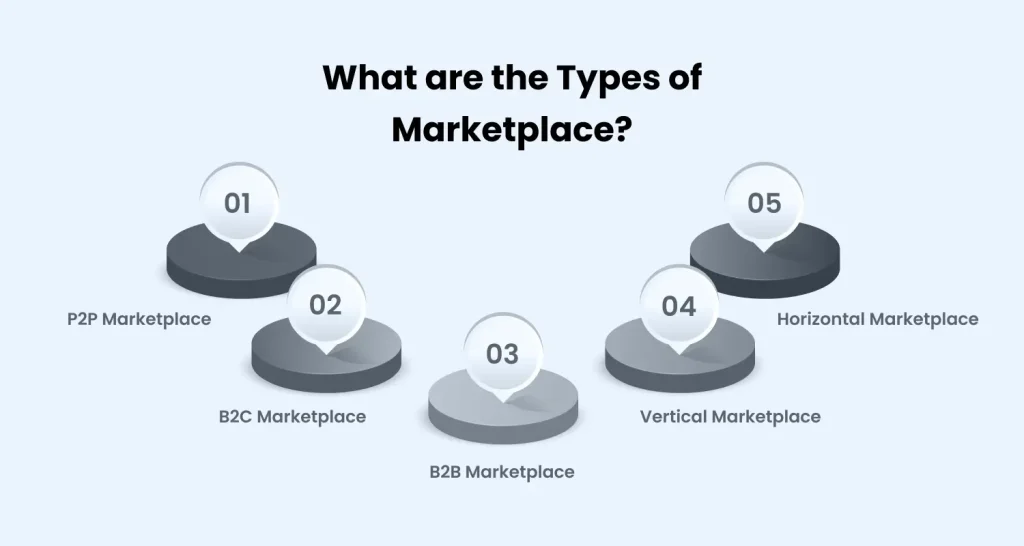More than 80% of all purchases made globally now occur online, marking a significant shift in the digital world. According to Forrester, marketplaces have become the preferred venues for B2B companies and are involved in 63% of all e-commerce transactions.
Online marketplaces continue to rule the online purchasing sector, controlling the most significant percentage of transactions globally, notwithstanding the recent decline in global e-commerce sales. Additionally, a 5% increase in sales rates is predicted for 2023, recovering from the pandemic’s effects and stabilizing during the ensuing years.
Your next question might be, “How much does it cost to build an online marketplace website?” We have painstakingly created a thorough guide explaining the step-by-step process of marketplace creation to provide clarity on this complex question.
So without further ado, let’s begin this informative investigation. Remember to rely on the knowledge of a trustworthy e-commerce website development firm when choosing the best development partner for your endeavor.
What are the Types of Marketplace?

To maximize your chance of success when entering the field of marketplace development, choosing the right kind of marketplace is essential. Understanding the various classes will produce the greatest results for your endeavor, whether you want to build a marketplace from scratch or improve your current infrastructure.
1. Peer-to-Peer (P2P) Marketplace
Also referred to as a customer-to-customer (C2C) marketplace, this business model focuses on letting customers sell and manage their goods or services directly to other consumers. This kind is shown by websites like Etsy, which give individuals or small groups a place to sell handmade things and display their artistic abilities. P2P marketplaces often impose fixed fees on vendors while permitting open sales. Uber is another well-known example of this approach because it makes peer-to-peer ridesharing possible.
2. Business-to-Customer (B2C) Marketplace
B2C marketplaces are geared towards companies looking to promote their goods or services to customers directly, without the aid of middlemen. Sellers who use this strategy provide a large choice of products, with AliExpress serving as a notable example and providing a huge selection of goods.
3. Business-to-Business (B2B) Marketplace
By introducing companies to new partners, B2B marketplace systems help firms improve their product distribution. The largest B2B portal in the world, Alibaba, which includes B2C and C2C transactions, is a great illustration. Alibaba, a collection of businesses that includes Guangzhou, Evergrande Taobao, F.C, UCWeb, 1688.com, and AliExpress, was founded in 1999 by Jack Ma and Peng Lei.
Markets can be categorized as vertical or horizontal in addition to the categories mentioned above.
4. Vertical Marketplace
Vertical marketplaces concentrate on particular populations, industries, or specializations. These marketplaces can save marketing expenses, provide more value to a smaller customer base, and increase revenue by focusing on a narrower audience. This strategy makes it simpler to maintain high-quality goods and services within a certain market. To differentiate yourself from rivals, you must have a thorough understanding of the chosen niche due to the generally low volume of transactions.
5. Horizontal Marketplace
In contrast to vertical marketplaces, horizontal marketplaces cover a wide range of categories and often focus on the most popular products to appeal to a larger audience. Since all sales operate under the same concept, horizontal marketplaces’ main benefit is their lower operational expenses. Horizontal marketplaces see a larger transaction volume and greater profitability by serving numerous target groups.
You may make an informed choice that is in line with your business objectives, target market, and preferred specialty by having a thorough understanding of the various marketplace kinds.

What is Online Marketplace Monetization?
Choosing the appropriate monetization strategy is essential when starting an online marketplace to guarantee the success of your venture. An online marketplace acts as a platform on the Internet where customers can buy products or services from numerous suppliers. Let’s look at the various alternatives you have for making money from your marketplace.
Charge a Fee for Every Transaction
One of the most popular ways to monetize an online marketplace is by collecting a fee for every transaction that involves money. The supplier, the buyer, or both parties to the transaction may be subject to this charge. This strategy is put into practice by websites like eBay that demand a commission from sales. Since the online platform only charges the seller once, sellers frequently prefer this method of monetization. Since they are only charged by the web platform once they make money, sellers frequently like this kind of monetization.
This strategy streamlines cash flows for marketplace operators because the web solution handles all financial processes. For marketplace operators to prevent parties from avoiding the middleman, it is essential to design a distinctive and user-friendly platform. Buyers look for unique goods, a variety of selections, and safe payment processes. A stable income and a steady stream of buyers from the market are important to suppliers.
Membership Fee
Under this business model, members of the marketplace must regularly pay a predetermined sum of money to access the platform and take advantage of its features to draw in new customers or providers. This method of revenue generation is ideal for online marketplaces that provide pricey goods and services. Subscription prices are reasonable for those who plan to use the chances offered by the market often.
Ad Posting Fee
Pay-per-placement monetization is a common strategy used by marketplaces that compile a lot of adverts. This business model is similar to the idea of paid advertising in that it enables providers to reach a larger client base while the platform guarantees a sizable audience. In the B2B market, this model is very advantageous. It is compatible with other business strategies, as evidenced by websites like Etsy. Less marketable things can still make money through listing fees while more popular items generate sales commissions.
Customer Contact Fee
In this well-liked business model, marketplace participants are compensated for contacting clients or producing leads. Users can post requests and wait for offers and responses from relevant sellers on several contemporary marketplace systems. To link a performer with a potential customer interested in their skills, the marketplace charges a fee. Even while this model doesn’t ensure profitable transactions, it raises the likelihood of success in comparison to running advertising.
Extended Features Fee
With this monetization strategy, consumers can use the service’s fundamental features without paying anything, but they can choose to pay for more sophisticated services if they so choose. The freemium business model enables users to take advantage of necessary capabilities without limitations. Paid services are extra features that offer improved security or convenience.
Featuring Ads Fee
With this strategy, businesses can secure a more noticeable position for their goods or services. Similar to advertising, marketplace vendors can pay to have their listings displayed in prominent locations on the website, such as the homepage or the first few pages of particular categories. It’s significant to remember that users could react negatively to excessive advertising. As a result, this strategy frequently performs better in specialized projects where the ads and offers fit with the overall design and demographics of the target audience.
You may like this: Build a Successful Two-Sided Marketplace
Tech Stack for Marketplace for Websites Development
Identifying the necessary features and taking into account MVP (Minimum Viable Product) development services are critical when determining the cost of developing an online marketplace.
Frontend Development
The client side of a website that users interact with directly is referred to as the front end. It covers all of the menus, buttons, and interface. Angular, JavaScript, and Webstorm are a few examples of technologies that can be used in the frontend web app development stack.
Backend Development
The backend is the platform’s server side, which is hidden from users. To provide seamless user functionality, it manages data storage, retrieval, and processing, supplying the relevant data from the data access layer upon request. Backend development might use Node.js, EC2, MySQL, Swagger, Express 4, and Sequelize as part of the tech stack.
Integrations
To incorporate different features into the product, it is frequently required to integrate third-party services. API integration enables developers to link numerous apps and streamline system-to-system data transfer. The following are some examples of frequently used integration tools: S3, PayPal, Stripe, Amazon SES, and Twilio.
Hiring web developers knowledgeable in these technologies is advised while creating an online marketplace to create a reliable and effective platform. Their proficiency in integrations, frontend, and backend development can help your marketplace website design be implemented successfully.
Core Features of Marketplace Website Development
Determining the features you want to include in your solution is essential when calculating the cost of developing an online marketplace. You can gradually add more features to improve your platform as your online store expands. Here are some essential features to think about.
New users can register and access your site with the help of these crucial features, registration, and authorization. Users who have registered can log in, list products, and do product searches.
Profiles: Give in-depth details about both suppliers and customers. Vendor profiles contain specialized information like product listings, shipping and payment options, and more.
Buyer Accounts: For a more individualized purchasing experience, pay attention to personal data, order history, and Wishlist.
Offering goods or services and making them appear to potential buyers is possible with item listings.
Advanced Search: Enables quick and simple browsing for customers to locate particular services or goods advertised by vendors.
Product pages should have thorough descriptions, high-quality images, and videos of each item to arouse the interest and trust of customers.
Customers can manage their chosen products, change quantities, evaluate available payment options and delivery costs, and complete the checkout process using the shopping cart.
Payment Options: Provide a variety of payment choices to accommodate your consumers’ preferences. Successful web solutions like Amazon, Shopify, and Zoom employ Stripe, a popular option.
Administrator Panel: Essential for the business owner to control various areas of the marketplace is the administrator panel. This includes monitoring fees, adjusting shipping and payment options, and keeping an eye on vendors’ listings, filters, and categories.
To ensure a smooth and effective development process, use web developers or a marketplace app development business with experience in designing web applications when creating your marketplace website.
You may like this: How to Find Investors for Your App Startup?
Cost to Build Marketplace App Development
There is no one-size-fits-all expense associated with creating a mobile marketplace app. The price varies depending on elements including the app’s size, the kinds of goods or services it offers, its marketing tactics, and the complexity of the features it needs.
It is advised to speak with experienced mobile app developers or app development firms to estimate the precise cost of creating your marketplace app. They can evaluate your particular needs, provide you with a price based on the features you want, and help you through the development process.
Take into account elements including the app’s complexity, the preferred platform (iOS, Android, or both), the user experience, and the development team’s experience. Full-stack developers from nations like India can be hired at a reasonable price, and they frequently offer high-quality services.
The specifics of your marketplace, the features you want to include, and the resources you commit to the project will ultimately determine the cost of developing a marketplace mobile app.
Conclusion
You now have a better grasp of how much it costs to construct a marketplace website and the advantages it may provide after reading the comprehensive guidance that was provided.
Our knowledgeable staff is available to help if you’re looking for a reliable online marketplace development firm. We have the know-how to design a marketplace website that is tailored to your particular needs. Please feel free to contact us to discuss your concept and to see if there are any ways to make your marketplace idea a reality. Don’t be hesitant to consult with our team of professionals as you move forward in the marketplace.
Frequently Asked Questions
How Can I Create An Online Marketplace From Scratch?
Follow these steps to create a marketplace website from scratch:
Identify your target market.
Conduct market research.
Select a reliable platform or technology.
Create a user-friendly and straightforward interface for customers and merchants.
Create a scalable and secure backend architecture.
Seamless user experience, test it thoroughly.
Launch an online marketplace.
Continuously evaluate and improve
How Much Does It Cost To Create A Marketplace With Multiple Vendors?
The complexity of the platform, the number of features, the requirements for the design, the length of the development process, and the level of experience of the development team can all affect how much it will cost to establish a multi-vendor marketplace. In addition, elements like customization, integration with outside services, and continuous maintenance need to be taken into account.
To obtain a precise cost estimate based on the requirements of your particular project, it is advised that you speak with a competent development agency. A simple marketplace can cost a few thousand dollars, whereas a big platform with many features might cost tens or hundreds of thousands of dollars.
Why Should I Use CMARIX To Build My Marketplace Website?
Expertise: CMARIX has a staff of talented engineers who specialize in creating reliable and scalable systems, and the company has vast expertise in creating marketplace websites.
Technology: To guarantee that your marketplace website is cutting-edge, effective, and safe, CMARIX makes use of the most recent frameworks and technologies.
Quality Control: CMARIX employs a stringent testing procedure to produce marketplace websites of the highest caliber that are error-free. They put the user experience first and guarantee fluid performance.
Support Services: CMARIX offers continuous support and upkeep services to make sure your marketplace website continues to function properly long after it has been launched.







